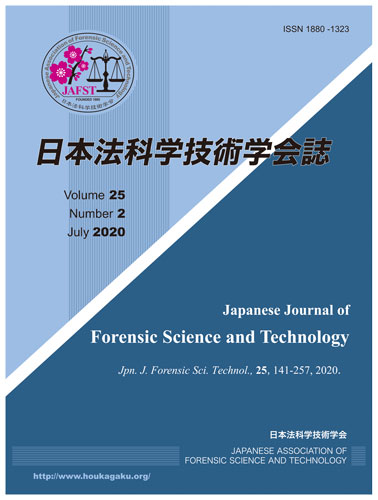Volume 25, Issue 2
Displaying 1-10 of 10 articles from this issue
- |<
- <
- 1
- >
- >|
Original Article
-
2020 Volume 25 Issue 2 Pages 141-150
Published: 2020
Released on J-STAGE: July 31, 2020
Advance online publication: January 11, 2020Download PDF (887K) -
2020 Volume 25 Issue 2 Pages 151-158
Published: 2020
Released on J-STAGE: July 31, 2020
Advance online publication: February 21, 2020Download PDF (500K) -
2020 Volume 25 Issue 2 Pages 159-170
Published: 2020
Released on J-STAGE: July 31, 2020
Advance online publication: February 18, 2020Download PDF (645K) -
2020 Volume 25 Issue 2 Pages 171-183
Published: 2020
Released on J-STAGE: July 31, 2020
Advance online publication: February 18, 2020Download PDF (3952K) -
2020 Volume 25 Issue 2 Pages 185-191
Published: 2020
Released on J-STAGE: July 31, 2020
Advance online publication: June 10, 2020Download PDF (595K)
Technical Note
-
2020 Volume 25 Issue 2 Pages 193-200
Published: 2020
Released on J-STAGE: July 31, 2020
Advance online publication: April 17, 2020Download PDF (1555K) -
2020 Volume 25 Issue 2 Pages 201-210
Published: 2020
Released on J-STAGE: July 31, 2020
Advance online publication: June 10, 2020Download PDF (974K) -
2020 Volume 25 Issue 2 Pages 211-222
Published: 2020
Released on J-STAGE: July 31, 2020
Advance online publication: June 16, 2020Download PDF (1135K)
Note
-
2020 Volume 25 Issue 2 Pages 223-243
Published: 2020
Released on J-STAGE: July 31, 2020
Advance online publication: February 21, 2020Download PDF (3010K)
Data
-
2020 Volume 25 Issue 2 Pages 245-257
Published: 2020
Released on J-STAGE: July 31, 2020
Advance online publication: April 27, 2020Download PDF (329K)
- |<
- <
- 1
- >
- >|
